Identification and Expression Analysis of the Populus trichocarpa GASA-Gene Family
Abstract
:1. Introduction
2. Results and Discussion
2.1. Composition and Protein Characteristics of the Poplar GASA-Gene Family
2.2. Distribution Characteristics of Poplar GASA Genes across the Chromosomes
2.3. Classification of the Poplar GASA-Gene Family
2.4. Homologous Genes and Functional Prediction of the PtGASA Genes in Arabidopsis and Apples
2.5. Exon–Intron Structure Analysis of PtGASA Genes
2.6. Analysis of GASA Gene Amplification and Conserved Motifs in Poplar
2.7. Spatial Structure and Subcellular Localization of Poplar GASA-Gene Family Proteins
2.8. Analysis of Cis-Acting Elements in Poplar GASA Promoters
2.9. Poplar GASA Gene Evolution and Collinearity
2.10. Expression Analysis of PtGASA Genes in Different Tissues of Populus Trichocarpa
3. Conclusions
4. Materials and Methods
4.1. Plant Materials
4.2. Experimental Methods
4.2.1. Data and Sequence Retrieval
4.2.2. Identification and Distribution Characteristics of Poplar GASA Genes
4.2.3. Multiple Sequence Alignment and Evolutionary Analysis of Poplar GASA Genes
4.2.4. Analysis of the Structure of Poplar GASA Genes
4.2.5. Spatial Structure and Subcellular Localization of Poplar GASA Proteins
4.2.6. Expression Analysis of Poplar GASA-Family Genes in Different Tissues
Supplementary Materials
Author Contributions
Funding
Institutional Review Board Statement
Informed Consent Statement
Data Availability Statement
Conflicts of Interest
References
- Zhao, T.; Xia, X.L.; Yin, W.L. Cloning and Functional Analysis of GASA Gene in Poplar. Guangdong Agric. Sci. 2012, 8, 138–140. [Google Scholar]
- Chen, B.; Sun, Y.; Tian, Z.; Fu, G.; Pei, X.; Pan, Z.; Nazir, M.F.; Song, S.; Li, H.; Wang, X.; et al. Ghgasa10–1 Promotes the Cell Elongation in Fiber Development through the Phytohormones IAA-Induced. BMC Plant Biol. 2021, 21, 448. [Google Scholar] [CrossRef]
- Yamaguchi, S. Gibberellin Metabolism and Its Regulation. Annu. Rev. Plant Biol. 2008, 59, 225–251. [Google Scholar] [CrossRef]
- Shi, L.; Gast, R.T.; Gopalraj, M.; Olszewski, N.E. Characterization of a Shoot-Specific, GA3- and ABA-Regulated Gene from Tomato. Plant J. 1992, 2, 153–159. [Google Scholar] [PubMed]
- Ben-Nissan, G.; Lee, J.-Y.; Borohov, A.; Weiss, D. GIP, a Petunia hybrida GA-Induced Cysteine-Rich Protein: A Possible Role in Shoot Elongation and Transition to Flowering. Plant J. 2004, 37, 229–238. [Google Scholar] [CrossRef] [PubMed]
- Segura, A.; Moreno, M.; Madueño, F.; Molina, A.; García-Olmedo, F. Snakin-1, a Peptide from Potato That Is Active against Plant Pathogens. Mol. Plant-Microbe Interact. 1999, 12, 16–23. [Google Scholar] [CrossRef] [Green Version]
- Zimmermann, R.; Sakai, H.; Hochholdinger, F. The Gibberellic Acid Stimulated-like Gene Family in Maize and Its Role in Lateral Root Development. Plant Physiol. 2009, 152, 356–365. [Google Scholar] [CrossRef] [Green Version]
- Wang, L.; Wang, Z.; Xu, Y.; Joo, S.-H.; Kim, S.-K.; Xue, Z.; Xu, Z.; Wang, Z.; Chong, K. Osgsr1 Is Involved in Crosstalk between Gibberellins and Brassinosteroids in Rice. Plant J. 2009, 57, 498–510. [Google Scholar] [CrossRef]
- De La Fuente, J.I.; Amaya, I.; Castillejo, C.; Sánchez-Sevilla, J.F.; Quesada, M.A.; Botella, M.A.; Valpuesta, V. The Strawberry Gene Fagast Affects Plant Growth Through Inhibition of Cell Elongation. J. Exp. Bot. 2006, 57, 2401–2411. [Google Scholar] [CrossRef]
- Zhang, S.; Wang, X. Expression Pattern of GASA, Downstream Genes of DELLA, in Arabidopsis. Chin. Sci. Bull. 2008, 53, 3839–3846. [Google Scholar] [CrossRef] [Green Version]
- Abdullah; Faraji, S.; Mehmood, F.; Malik, H.M.T.; Ahmed, I.; Heidari, P.; Poczai, P. The GASA Gene Family in Cacao (Theobroma Cacao, Malvaceae): Genome Wide Identification and Expression Analysis. Agronomy 2021, 11, 1425. [Google Scholar]
- Nahirñak, V.; Rivarola, M.; Urreta, M.G.D.; Paniego, N.; Hopp, H.E.; Almasia, N.I.; Vazquez-Rovere, C. Genome-Wide Analysis of the Snakin/ GASA Gene Family in Solanum Tuberosum Cv. Kennebec. Am. J. Potato Res. 2016, 93, 172–188. [Google Scholar] [CrossRef]
- Sun, S.; Wang, H.; Yu, H.; Zhong, C.; Zhang, X.; Peng, J.; Wang, X. GASA14 Regulates Leaf Expansion and Abiotic Stress Resistance By Modulating Reactive Oxygen Species Accumulation. J. Exp. Bot. 2013, 64, 1637–1647. [Google Scholar] [CrossRef] [PubMed] [Green Version]
- Rubinovich, L.; Weiss, D. The Arabidopsis Cysteine-Rich Protein GASA4 Promotes GA Responses and Exhibits Redox Activity in Bacteria and in Planta. Plant J. 2010, 64, 1018–1027. [Google Scholar] [CrossRef]
- Qu, J.; Kang, S.G.; Hah, C.; Jang, J.-C. Molecular and Cellular Characterization of GA-Stimulated Transcripts GASA4 and GASA6 in Arabidopsis Thaliana. Plant Sci. 2016, 246, 1–10. [Google Scholar] [CrossRef]
- Fan, S.; Zhang, D.; Zhang, L.; Gao, C.; Xin, M.; Tahir, M.M.; Li, Y.; Ma, J.; Han, M. Comprehensive Analysis of GASA Family Members in the Malus Domestica Genome: Identification, Characterization, and Their Expressions in Response to Apple Flower Induction. BMC Genom. 2017, 18, 827. [Google Scholar] [CrossRef]
- Muhammad, I.; Li, W.-Q.; Jing, X.-Q.; Zhou, M.-R.; Shalmani, A.; Ali, M.; Wei, X.-Y.; Sharif, R.; Liu, W.-T.; Chen, K.-M. A Systematic In Silico Prediction of Gibberellic Acid Stimulated GASA Family Members: A Novel Small Peptide Contributes to Floral Architecture and Transcriptomic Changes Induced By External Stimuli in Rice. J. Plant Physiol. 2019, 234–235, 117–132. [Google Scholar] [CrossRef]
- Zhang, S.; Yang, C.; Peng, J.; Sun, S.; Wang, X. GASA5, a Regulator of Flowering Time and Stem Growth in Arabidopsis Thaliana. Plant Mol. Biol. 2009, 69, 745–759. [Google Scholar] [CrossRef]
- Alonso-Ramírez, A.; Rodríguez, D.; Reyes, D.; Jiménez, J.S.A.; Nicolás, G.; López-Climent, M.A.; Gómez-Cadenas, A.; Nicolás, C. Evidence for a Role of Gibberellins in Salicylic Acid-Modulated Early Plant Responses to Abiotic Stress in Arabidopsis Seeds. Plant Physiol. 2009, 150, 1335–1344. [Google Scholar] [CrossRef] [Green Version]
- Chen, K.; Liu, W.; Li, X.; Li, H. Overexpression of Gmgasa32 Promoted Soybean Height By Interacting with Gmcdc25. Plant Signal. Behav. 2021, 16, 1855017. [Google Scholar] [CrossRef]
- Wu, T.; Cheng, C.; Zhong, Y.; Lv, Y.; Ma, Y.; Zhong, G. Molecular Characterization of the Gibberellin-Stimulated Transcript of GASA4 in Citrus. Plant Growth Regul. 2020, 91, 89–99. [Google Scholar] [CrossRef] [Green Version]
- Chen, I.-C.; Lee, S.-C.; Pan, S.-M.; Hsieh, H.-L. GASA4, a GA-Stimulated Gene, Participates in Light Signaling in Arabidopsis. Plant Sci. 2007, 172, 1062–1071. [Google Scholar] [CrossRef]
- Tuoya, D. Origin, Divergence and Geographical Distribution of Salicaceae. Actabotanicayunnanica 1995, 03, 277–290. [Google Scholar]
- Yu, X.; Lu, B.; Dong, Y.; Li, Y.; Yang, M. Cloning and Functional Identification of Pewrky41 from Populus × Euramericana. Ind. Crops Prod. 2022, 175, 114279. [Google Scholar] [CrossRef]
- Xu, W.; Wu, Z.H.; Zou, Y.Y. Development and Application of High-Valued Wood Products Made of Fast-Growing Poplar. Adv. Mater. Res. 2011, 311–313, 117–121. [Google Scholar] [CrossRef]
- Thakur, A.K.; Kumar, P.; Parmar, N.; Shandil, R.K.; Aggarwal, G.; Gaur, A.; Srivastava, D.K. Achievements and Prospects of Genetic Engineering in Poplar: A Review. New For. 2021, 52, 889–920. [Google Scholar] [CrossRef]
- Wei, H.; Movahedi, A.; Liu, G.; Li, Y.; Liu, S.; Yu, C.; Chen, Y.; Zhong, F.; Zhang, J. Genome-Wide Characterization and Abiotic Stresses Expression Analysis of Annexin Family Genes in Poplar. Int. J. Mol. Sci. 2022, 23, 515. [Google Scholar] [CrossRef]
- Wang, S.; Lu, W.; Zhang, F. Vertical Distribution and Controlling Factors of Soil Inorganic Carbon in Poplar Plantations of Coastal Eastern China. Forests 2022, 13, 83. [Google Scholar] [CrossRef]
- Ahmad, M.Z.; Sana, A.; Jamil, A.; Nasir, J.A.; Ahmed, S.; Hameed, M.U. A Genome-Wide Approach to the Comprehensive Analysis of GASA Gene Family in Glycine Max. Plant Mol. Biol. 2019, 100, 607–620. [Google Scholar] [CrossRef]
- Heidari, P.; Ahmadizadeh, M.; Izanlo, F.; Nussbaumer, T. In Silico Study of the CESA and CSL Gene Family in Arabidopsis Thaliana and Oryza Sativa: Focus On Post-Translation Modifications. Plant Gene 2019, 19, 100189. [Google Scholar] [CrossRef]
- Xu, G.; Guo, C.; Shan, H.; Kong, H. Divergence of Duplicate Genes in Exon-Intron Structure. Proc. Natl. Acad. Sci. USA 2012, 109, 1187–1192. [Google Scholar] [CrossRef] [PubMed] [Green Version]
- Mao, K.; Dong, Q.; Li, C.; Liu, C.; Ma, F. Genome Wide Identification and Characterization of Apple Bhlh Transcription Factors and Expression Analysis in Response to Drought and Salt Stress. Front. Plant Sci. 2017, 8, 480. [Google Scholar] [CrossRef] [PubMed] [Green Version]
- Ahmad, B.; Yao, J.; Zhang, S.; Li, X.; Zhang, X.; Yadav, V.; Wang, X. Genome-Wide Characterization and Expression Profiling of GASA Genes During Different Stages of Seed Development in Grapevine (Vitis vinifera L.) Predict Their Involvement in Seed Development. Int. J. Mol. Sci. 2020, 21, 1088. [Google Scholar] [CrossRef] [PubMed] [Green Version]
- Lu, L.; Chen, X.; Zhang, Y.; Liu, Q.; Wang, L.; Ma, L.; Li, H. Bioinformatic Identification of GASA Gene Family Expression Profiles in Wheat. Crops 2018, 6, 58–67. [Google Scholar]
- Zhang, S.; Wang, X. Overexpression of GASA5 Increases the Sensitivity of Arabidopsis to Heat Stress. J. Plant Physiol. 2011, 168, 2093–2101. [Google Scholar] [CrossRef]
- Ren, R.; Wang, H.; Guo, C.; Zhang, N.; Zeng, L.; Chen, Y.; Ma, H.; Qi, J. Widespread Whole Genome Duplications Contribute to Genome Complexity and Species Diversity in Angiosperms. Mol. Plant 2018, 11, 414–428. [Google Scholar] [CrossRef] [Green Version]
- Qu, Y.; Bi, C.; He, B.; Ye, N.; Yin, T.; Xu, L.-A. Genome-Wide Identification and Characterization of the MADS-Box Gene Family in Salix Suchowensis. PeerJ 2019, 7, E8019. [Google Scholar] [CrossRef] [Green Version]
- He, H.; Dong, Q.; Shao, Y.; Jiang, H.; Zhu, S.; Cheng, B.; Xiang, Y. Genome-wide survey and characterization of the WRKY gene family in Populus trichocarpa. Plant Cell Rep. 2012, 31, 1199–1217. [Google Scholar] [CrossRef]
- Zhang, J.; Li, Z.; Wu, H.; Zhao, W.; Pan, Z.; Bai, S.; Tong, C. Whole Genome Duplication Events and Evolutionary Analyses of Several Populus Species. Mol. Plant Breed. 2021, 1–12. [Google Scholar]
- Wang, Y.; Feng, L.; Zhu, Y.; Li, Y.; Yan, H.; Xiang, Y. Comparative genomic analysis of the WRKY III gene family in populus, grape, arabidopsis and rice. Biology Direct. 2015, 10, 48. [Google Scholar] [CrossRef] [Green Version]
- Zhu, Y.; Yan, H.; Wang, Y.; Feng, L.; Chen, Z.; Xiang, Y. Genome Duplication and Evolution of Heat Shock Transcription Factor (HSF) Gene Family in Four Model Angiosperms. J. Plant Growth Regul. 2016, 35, 903–920. [Google Scholar] [CrossRef]
- Nawaz, Z.; Kakar, K.U.; Saand, M.A.; Shu, Q.-Y. Cyclic Nucleotide-Gated Ion Channel Gene Family in Rice, Identification, Characterization and Experimental Analysis of Expression Response to Plant Hormones, Biotic and Abiotic Stresses. BMC Genom. 2014, 15, 853. [Google Scholar] [CrossRef] [Green Version]
- Goodstein, D.M.; Shu, S.; Howson, R.; Neupane, R.; Hayes, R.D.; Fazo, J.; Mitros, T.; Dirks, W.; Hellsten, U.; Putnam, N.; et al. Phytozome: A Comparative Platform for Green Plant Genomics. Nucleic Acids Res. 2011, 40, D1178–D1186. [Google Scholar] [CrossRef] [PubMed]
- Consortium, T.U. Uniprot: The Universal Protein Knowledgebase in 2021. Nucleic Acids Res. 2020, 49, D480–D489. [Google Scholar] [CrossRef] [PubMed]
- Schultz, J.; Milpetz, F.; Bork, P.; Ponting, C.P. SMART, a Simple Modular Architecture Research Tool: Identification of Signaling Domains. Proc. Natl. Acad. Sci. USA 1998, 95, 5857–5864. [Google Scholar] [CrossRef] [PubMed] [Green Version]
- Marchler-Bauer, A.; Derbyshire, M.K.; Gonzales, N.R.; Lu, S.; Chitsaz, F.; Geer, L.Y.; Geer, R.C.; He, J.; Gwadz, M.; Hurwitz, D.I.; et al. CDD: NCBI’s Conserved Domain Database. Nucleic Acids Res. 2014, 43, D222–D226. [Google Scholar] [CrossRef] [PubMed] [Green Version]
- Chen, C.; Chen, H.; Zhang, Y.; Thomas, H.R.; Frank, M.H.; He, Y.; Xia, R. Tbtools: An Integrative Toolkit Developed for Interactive Analyses of Big Biological Data. Mol. Plant 2020, 13, 1194–1202. [Google Scholar] [CrossRef] [PubMed]
- Bi, C.; Xu, Y.; Ye, Q.; Yin, T.; Ye, N. Genome-Wide Identification and Characterization of WRKY Gene Family in Salix Suchowensis. PeerJ 2016, 4, E2437. [Google Scholar] [CrossRef] [Green Version]
- Schmittgen, T.D.; Livak, K.J. Analyzing Real-Time PCR Data By the Comparative CT Method. Nat. Protoc. 2008, 3, 1101–1108. [Google Scholar] [CrossRef]


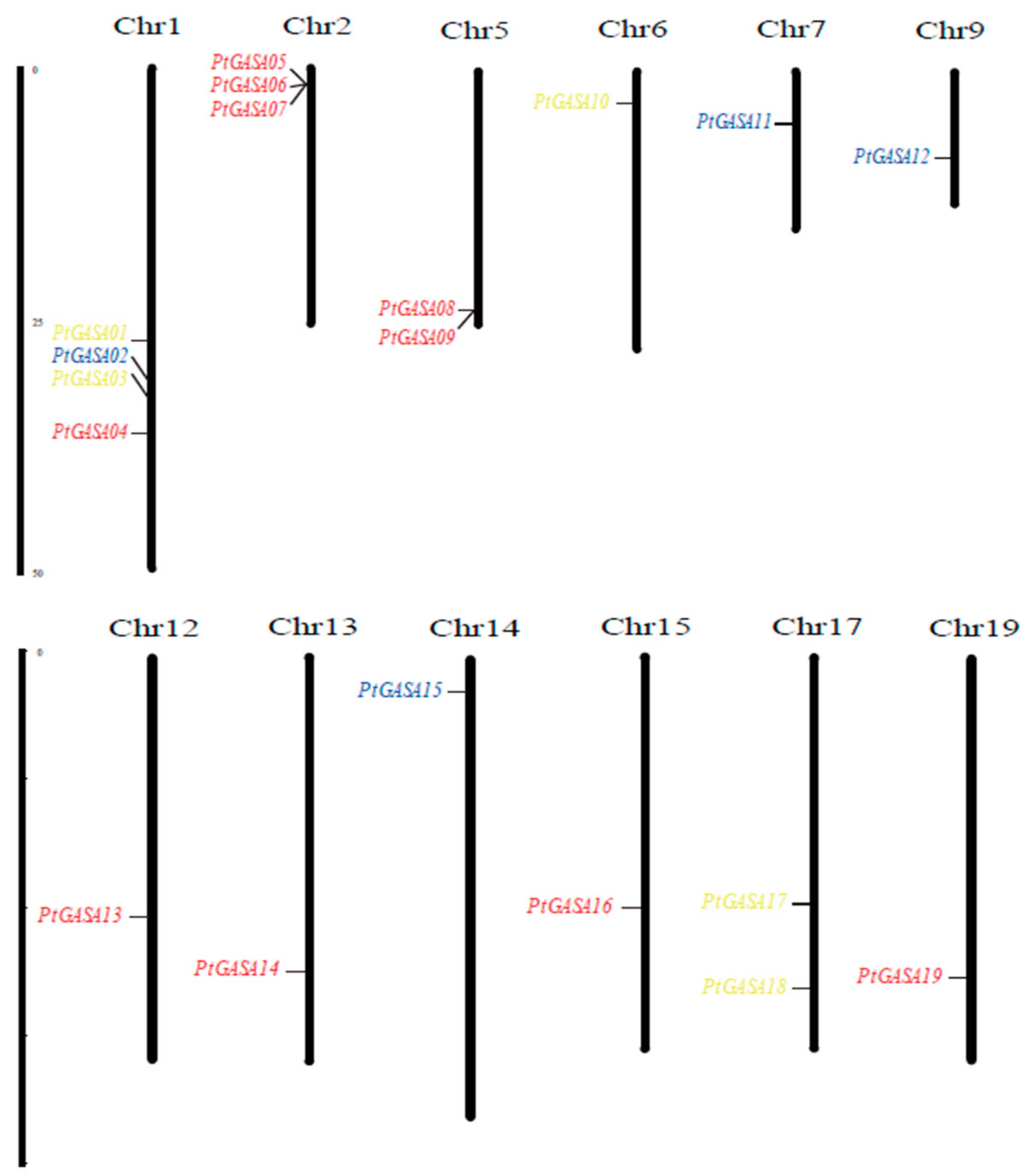
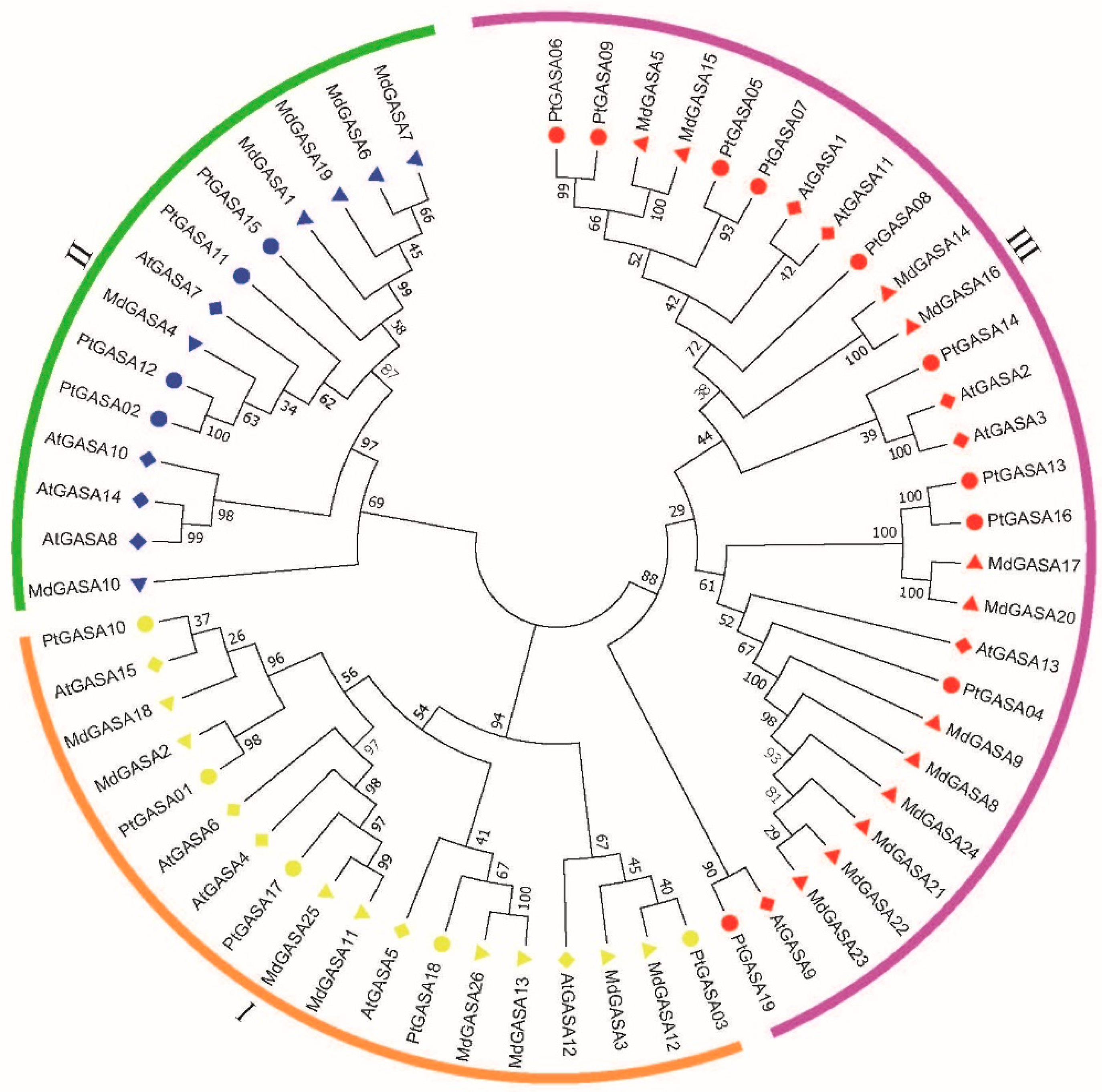
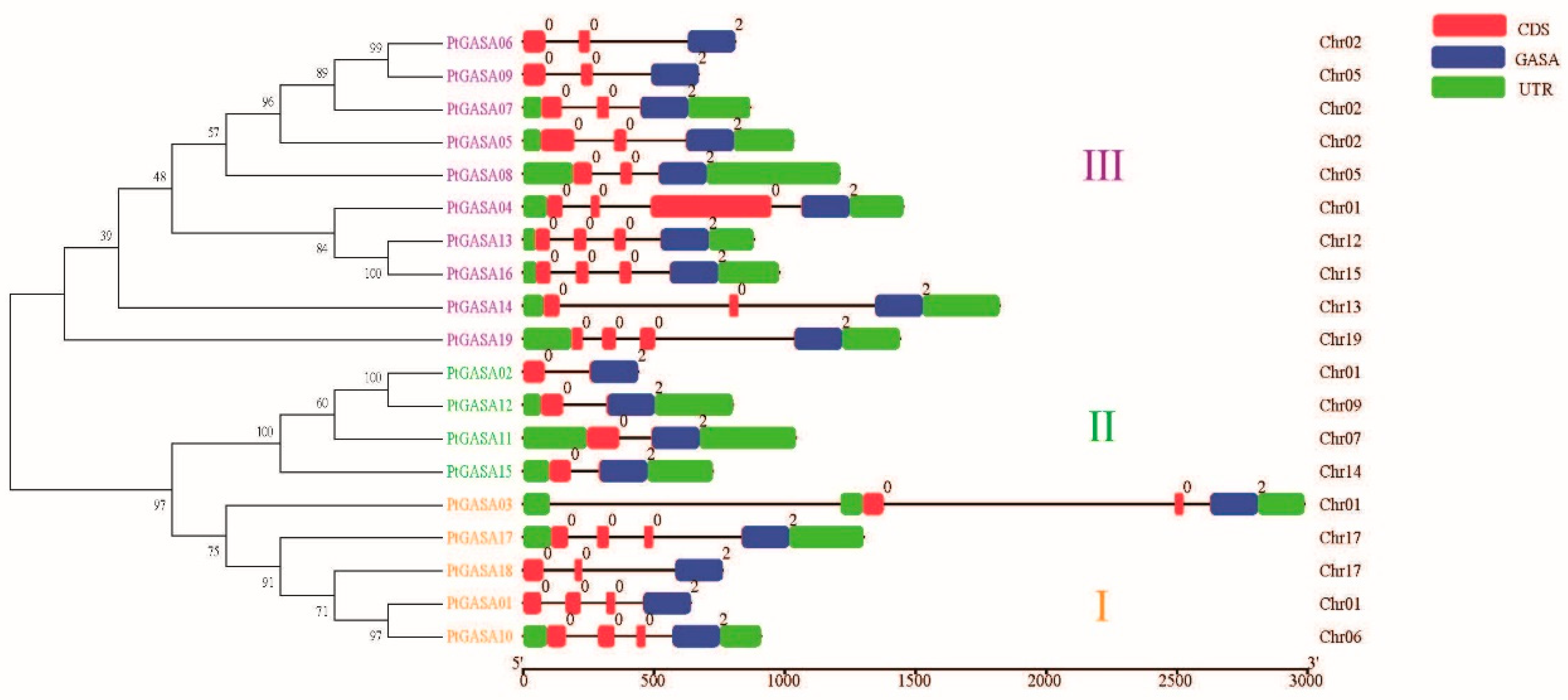
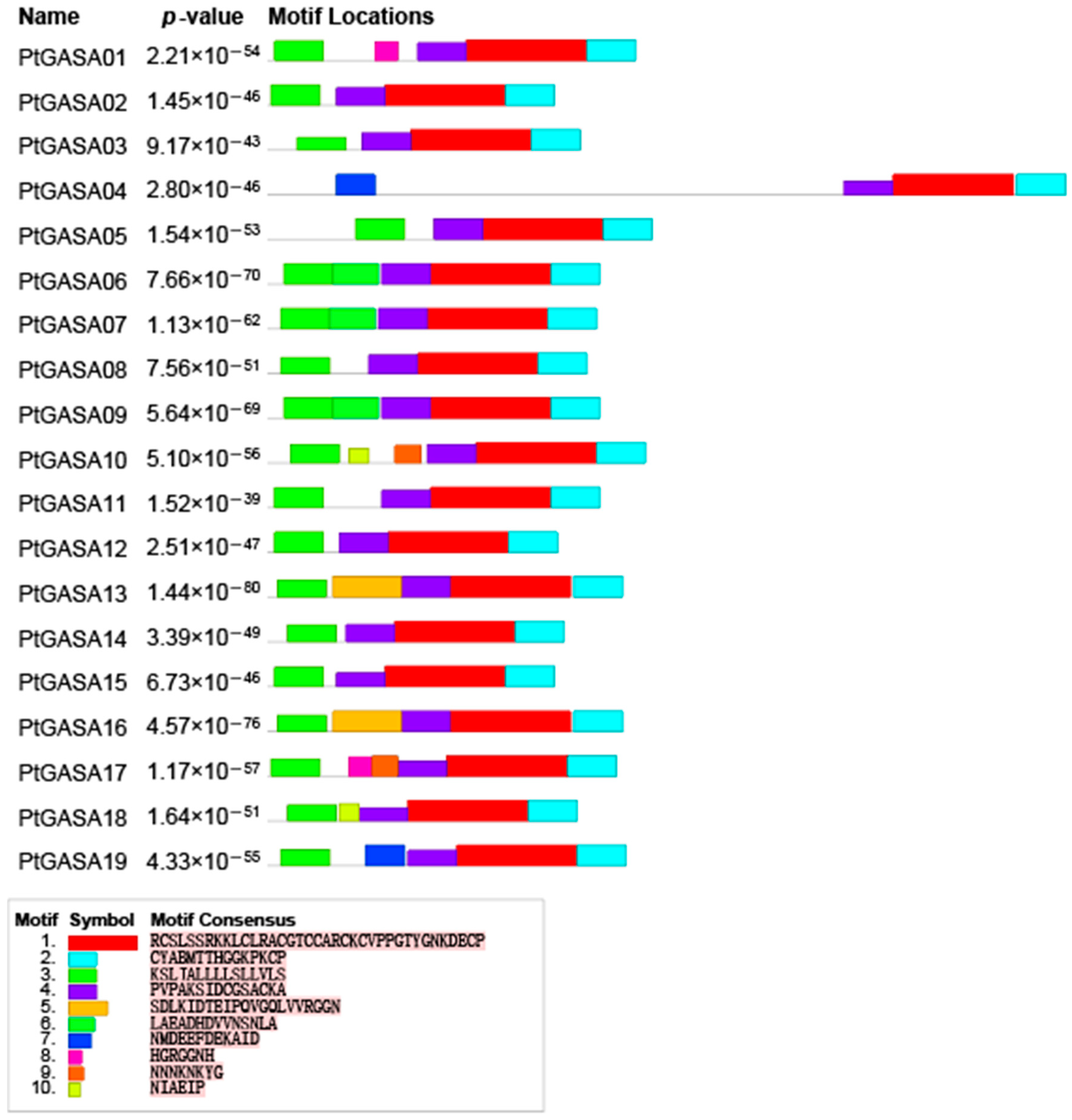
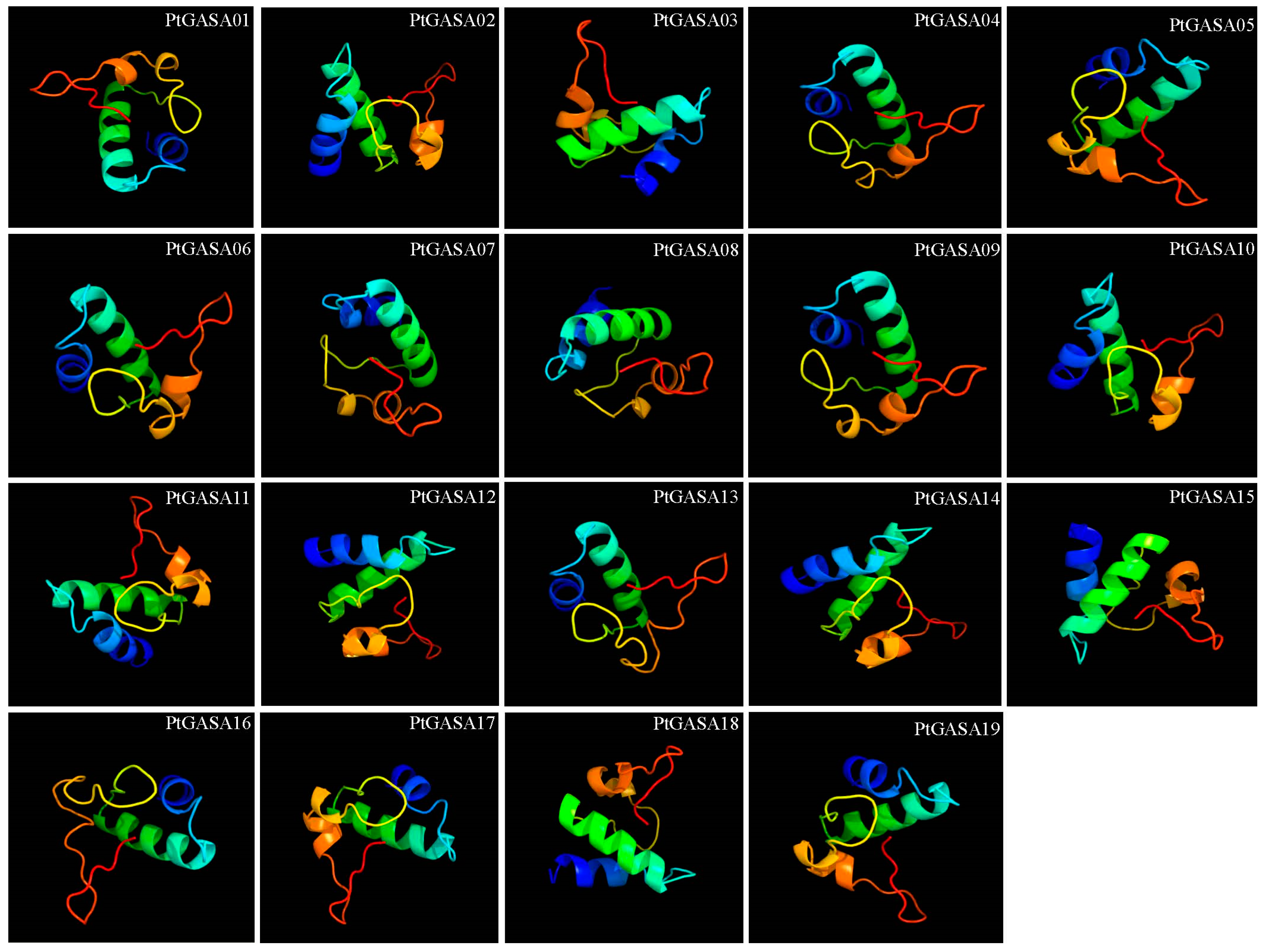
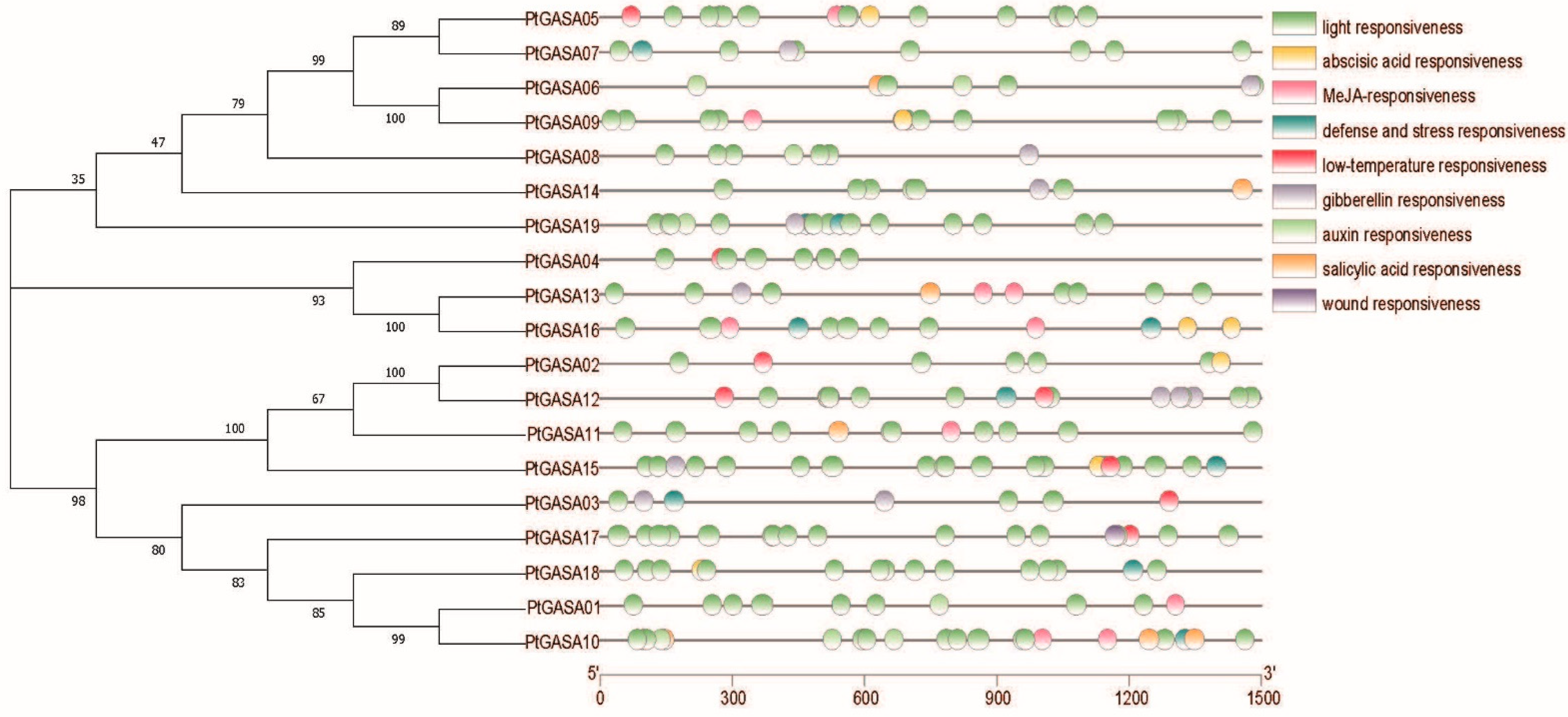
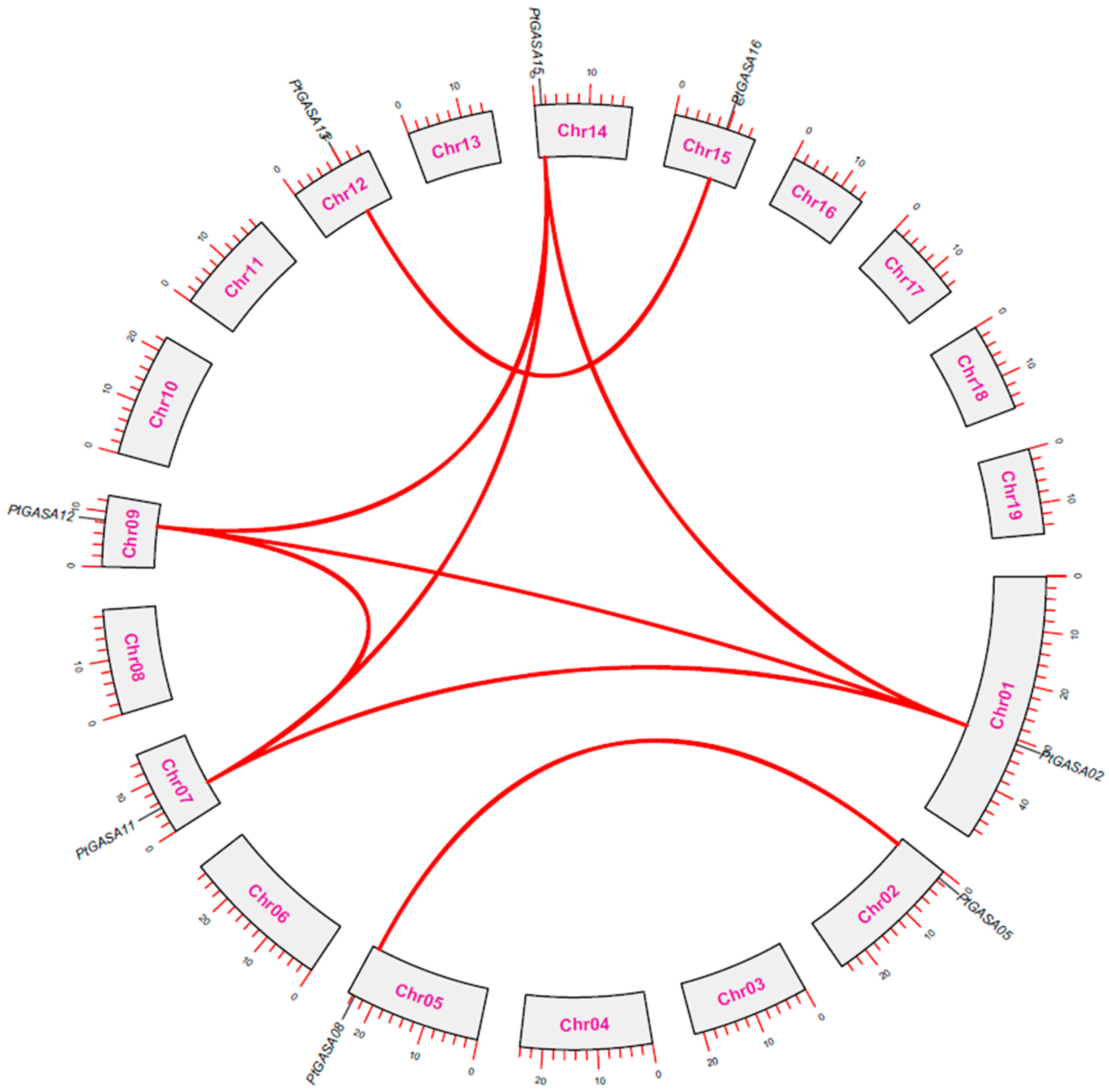
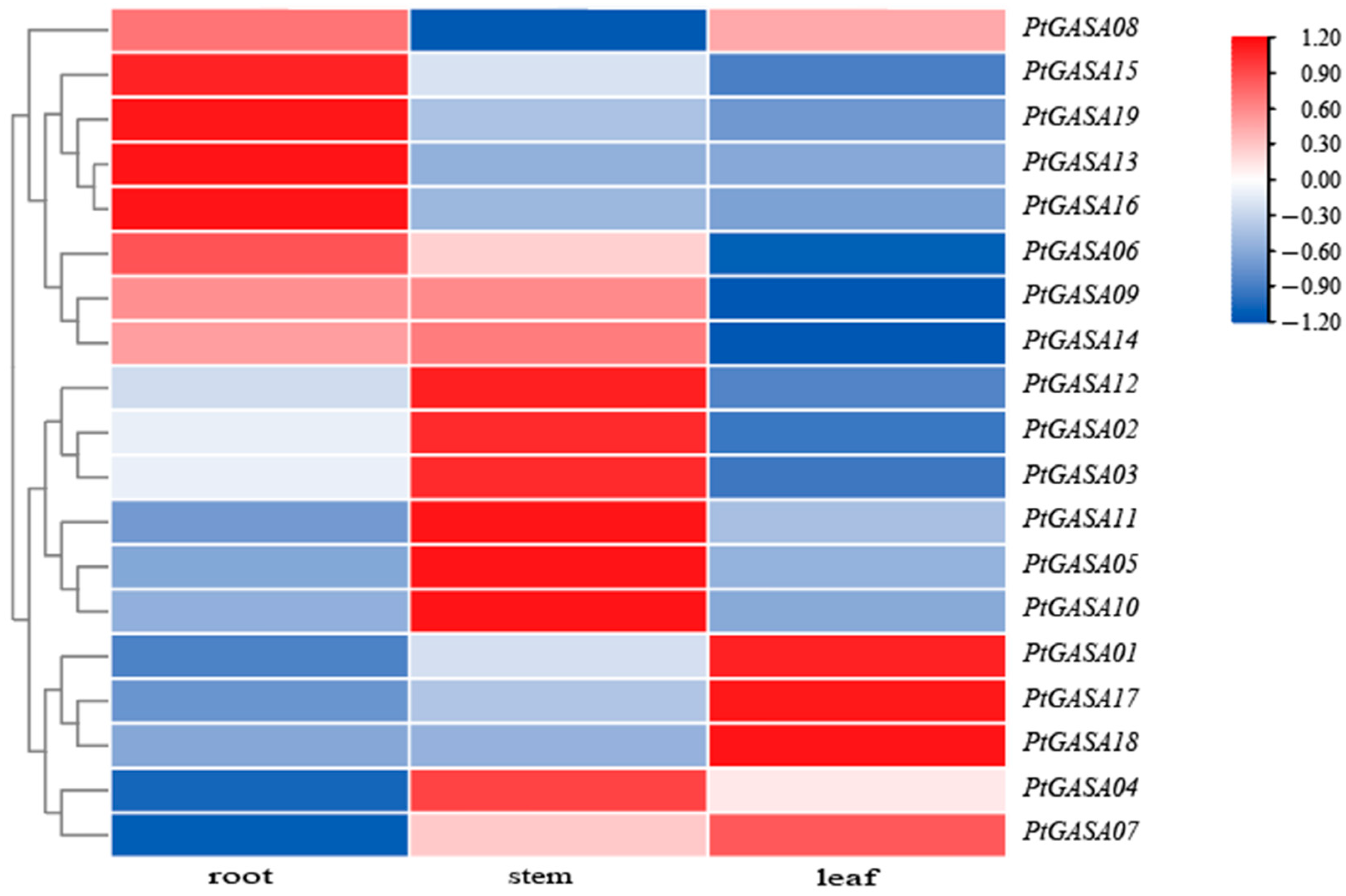
| Gene ID | Sequence ID | Length (aa) | MW (kDa) | PI | Instability Index | GRAVY | Aliphatic Index |
|---|---|---|---|---|---|---|---|
| PtGASA01 | Potri.001G254100.2.p | 113 | 12.26 | 9.48 | 43.90 | −0.250 | 60.53 |
| PtGASA02 | Potri.001G297700.1.p | 88 | 9.80 | 9.12 | 37.23 | −0.203 | 56.59 |
| PtGASA03 | Potri.001G315500.1.p | 96 | 10.33 | 7.96 | 52.40 | −0.014 | 61.04 |
| PtGASA04 | Potri.001G350600.3.p | 245 | 25.85 | 9.83 | 82.98 | −0.477 | 49.27 |
| PtGASA05 | Potri.002G022500.1p | 118 | 12.36 | 9.20 | 43.25 | −0.019 | 76.95 |
| PtGASA06 | Potri.002G022600.2p | 102 | 10.77 | 9.03 | 59.91 | 0.004 | 70.95 |
| PtGASA07 | Potri.002G022700.1p | 101 | 10.57 | 9.18 | 48.37 | 0.007 | 83.17 |
| PtGASA08 | Potri.005G239000.2.p | 98 | 10.33 | 8.00 | 36.62 | 0.107 | 73.82 |
| PtGASA09 | Potri.005G239100.2.p | 102 | 10.83 | 8.66 | 55.48 | 0.317 | 80.61 |
| PtGASA10 | Potri.006G044400.1.p | 116 | 12.72 | 9.36 | 57.86 | −0.443 | 58.02 |
| PtGASA11 | Potri.007G051300.1.p | 102 | 11.17 | 9.05 | 47.30 | −0.015 | 67.94 |
| PtGASA12 | Potri.009G092600.1.p | 89 | 9.95 | 9.11 | 34.21 | −0.245 | 55.96 |
| PtGASA13 | Potri.012G076700.1.p | 109 | 11.93 | 8.75 | 36.72 | −0.012 | 77.71 |
| PtGASA14 | Potri.013G113400.3.p | 91 | 10.04 | 8.97 | 49.23 | −0.221 | 60.11 |
| PtGASA15 | Potri.014G020100.1.p | 88 | 9.65 | 9.01 | 27.19 | 0.003 | 57.61 |
| PtGASA16 | Potri.015G071500.1.p | 109 | 11.77 | 8.88 | 35.07 | 0.081 | 79.45 |
| PtGASA17 | Potri.017G083000.1.p | 107 | 11.90 | 9.54 | 42.59 | −0.305 | 54.67 |
| PtGASA18 | Potri.017G124200.1.p | 95 | 10.57 | 9.14 | 42.43 | −0.119 | 66.74 |
| PtGASA19 | Potri.019G083900.1.p | 110 | 12.18 | 9.47 | 54.87 | −0.244 | 71.91 |
| No. | Gene Name | Homologous Gene | Category | Identify (%) |
|---|---|---|---|---|
| 1 | PtGASA01 | PtGASA10 | I | 75 |
| 2 | PtGASA02 | PtGASA15 | II | 73.86 |
| 3 | PtGASA02 | PtGASA12 | II | 96.55 |
| 4 | PtGASA05 | PtGASA06 | III | 65.05 |
| 5 | PtGASA05 | PtGASA07 | III | 78.22 |
| 6 | PtGASA05 | PtGASA09 | III | 65 |
| 7 | PtGASA06 | PtGASA09 | III | 90.20 |
| 8 | PtGASA06 | PtGASA07 | III | 73.74 |
| 9 | PtGASA07 | PtGASA09 | III | 74 |
| 10 | PtGASA12 | PtGASA15 | III | 74.16 |
| 11 | PtGASA13 | PtGASA16 | III | 91.74 |
Publisher’s Note: MDPI stays neutral with regard to jurisdictional claims in published maps and institutional affiliations. |
© 2022 by the authors. Licensee MDPI, Basel, Switzerland. This article is an open access article distributed under the terms and conditions of the Creative Commons Attribution (CC BY) license (https://creativecommons.org/licenses/by/4.0/).
Share and Cite
Wu, K.; Qu, Y.; Rong, H.; Han, X.; Tian, Y.; Xu, L. Identification and Expression Analysis of the Populus trichocarpa GASA-Gene Family. Int. J. Mol. Sci. 2022, 23, 1507. https://doi.org/10.3390/ijms23031507
Wu K, Qu Y, Rong H, Han X, Tian Y, Xu L. Identification and Expression Analysis of the Populus trichocarpa GASA-Gene Family. International Journal of Molecular Sciences. 2022; 23(3):1507. https://doi.org/10.3390/ijms23031507
Chicago/Turabian StyleWu, Kai, Yanshu Qu, Hao Rong, Xin Han, Yating Tian, and Li’an Xu. 2022. "Identification and Expression Analysis of the Populus trichocarpa GASA-Gene Family" International Journal of Molecular Sciences 23, no. 3: 1507. https://doi.org/10.3390/ijms23031507
APA StyleWu, K., Qu, Y., Rong, H., Han, X., Tian, Y., & Xu, L. (2022). Identification and Expression Analysis of the Populus trichocarpa GASA-Gene Family. International Journal of Molecular Sciences, 23(3), 1507. https://doi.org/10.3390/ijms23031507






